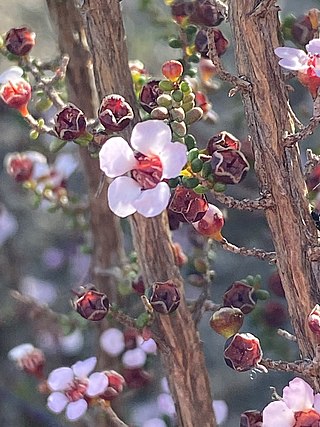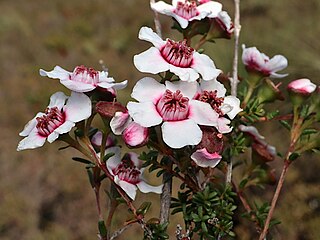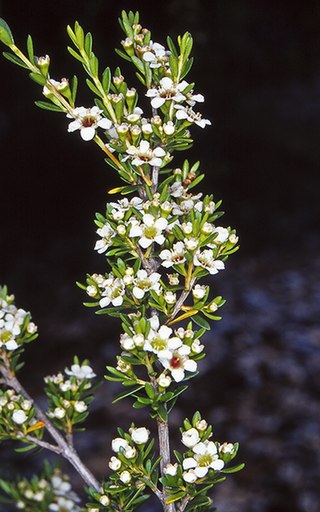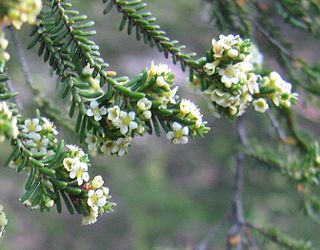
Rinzia orientalis, commonly known as desert heath-myrtle, is a species of flowering plant in the family Myrtaceae and is endemic to south-eastern Australia. It is a shrub with elliptic to narrowly oblong leaves and white or pale pink flowers usually with ten stamens.
Balaustion grandibracteatum is a species of flowering plant in the family Myrtaceae and is endemic to inland Western Australia. It is a shrub with mostly narrowly oblong to elliptic leaves and white flowers with 14 to 27 stamens.
Austrobaeckea latens is a species of flowering plant in the family Myrtaceae and is endemic to the south of Western Australia. It is an upright, spreading shrub with erect, linear leaves and small white flowers with three to ten stamens.
Austrobaeckea pygmaea is a species of flowering plant in the family Myrtaceae and is endemic to the south-west of Western Australia. It is a slender and erect or spreading shrub with narrowly egg-shaped to almost linear leaves and small white flowers with 12 to 25 stamens.
Austrobaeckea uncinella is a species of flowering plant in the family Myrtaceae and is endemic to the south coast of Western Australia. It is a shrub with narrowly egg-shaped to linear leaves and small white flowers with seven to thirteen stamens.
Micromyrtus acuta is a species of flowering plant in the myrtle family, Myrtaceae and is endemic to the southwest of Western Australia. It is an erect shrub with small, oblong leaves and small white flowers in the upper leaf axils.

Micromyrtus elobata is a species of flowering plant in the myrtle family, Myrtaceae and is endemic to the south of Western Australia. It is usually an erect shrub with small, narrowly to broadly egg-shaped leaves with the narrower end towards the base, and white flowers 3–5 mm (0.12–0.20 in) in diameter.
Micromyrtus imbricata is a species of the family Myrtaceae and is endemic to the south of Western Australia. It is a slender, erect shrub with broadly egg-shaped leaves, white, pink or red-tinged flowers 4–5 mm (0.16–0.20 in) in diameter, and 10 stamens.

Micromyrtus racemosa is species of the flowering plant in the family Myrtaceae and is endemic to the south-west of Western Australia. It is a shrub with relatively thick, narrowly egg-shaped leaves, sometimes with the narrower end toward the base, and white, cream-coloured or yellow flowers 2.5–4.0 mm (0.098–0.157 in) in diameter.

Micromyrtus redita is species of the flowering plant in the family Myrtaceae and is endemic to the south-west of Western Australia. It is a densely branched shrub with narrowly oblong to elliptic leaves, reddish sepals and white or pink petals.
Micromyrtus rogeri is a species of flowering plant in the family Myrtaceae and is endemic to the south-west of Western Australia. It is shrub with egg-shaped leaves with the narrower end towards the base, and white flowers with 10 stamens.
Thryptomene globifera is a species of flowering plant in the family Myrtaceae and is endemic to western areas of Western Australia. It is a shrub with crowded, upward-pointing, broadly egg-shaped leaves with the narrower end towards the base, and pale pink or mauve flowers with ten stamens.
Thryptomene podantha is a species of flowering plant in the family Myrtaceae and is endemic to the west of Western Australia. It is a shrub with egg-shaped leaves with the narrower end towards the base, and flowers with pink sepals and petals and ten stamens.
Thryptomene repens is a species of flowering plant in the family Myrtaceae and is endemic to a restricted area in the west of Western Australia. It is a prostrate shrub with egg-shaped leaves with the narrower end towards the base, and flowers with pink sepals and petals and ten stamens.
Babingtonia erecta is a species of flowering plant in the family Myrtaceae and is endemic to the southwest of Western Australia. It is an erect shrub with densely clustered, linear leaves and white or pale pink flowers in groups two to seven in leaf axils, each flower with 8 to 14 stamens.

Babingtonia grandiflora, commonly known as the large flowered babingtonia, is a species of flowering plant in the family Myrtaceae. It is a common heathland shrub endemic to the coastal southwest of Western Australia. It is a shrub with erect or arching stems, linear leaves and white or pale pink flowers usually arranged singly in leaf axils, each flower with 11 to 25 stamens. Babingtonia grandiflora flowers from August to December.
Babingtonia maleyae, commonly known as the Narrogin babingtonia, is a species of flowering plant in the family Myrtaceae and is endemic to the southwest of Western Australia. It is a compact shrub with narrowly egg-shaped to elliptic leaves and white flowers usually arranged singly in leaf axils, each flower with 17 to 20 stamens.

Thryptomene parviflora is a species of flowering plant in the family Myrtaceae and is endemic to Queensland. It is a slender, erect shrub with decussate, linear to egg-shaped leaves with the narrower end towards the base, and flowers with five petals and five stamens arranged singly in leaf axils.

Baeckea latifolia is a species of flowering plant in the family Myrtaceae and is endemic to south-eastern continental Australia. It is a shrub with broadly elliptic leaves and small white flowers with six to eight stamens.

Micromyrtus hexamera is a species of flowering plant in the myrtle family, Myrtaceae and is endemic to Queensland. It is a shrub with erect or spreading branchlets, overlapping linear leaves, and white flowers arranged singly in leaf axils with 5 stamens in each flower.







